There’s a rather interesting Discover magazine article called Three Words That Could Overthrow Physics: “What Is Magnetism?”. It was written by Bruno Maddox in 2008. The subtitle is “The standard model still doesn’t describe magnets’ spooky action at a distance”. Maddox was on holiday reading Electronics for Dummies when he realised that he didn’t how a magnet works. He said this: “I set out on what I assumed would be a minutes-long odyssey to understand the phenomenon. Seventy-one days later, I am here with astonishing findings. For one thing, as far as I can tell, nobody knows how a magnet can move a piece of metal without touching it. And for another—more astonishing still, perhaps—nobody seems to care”.
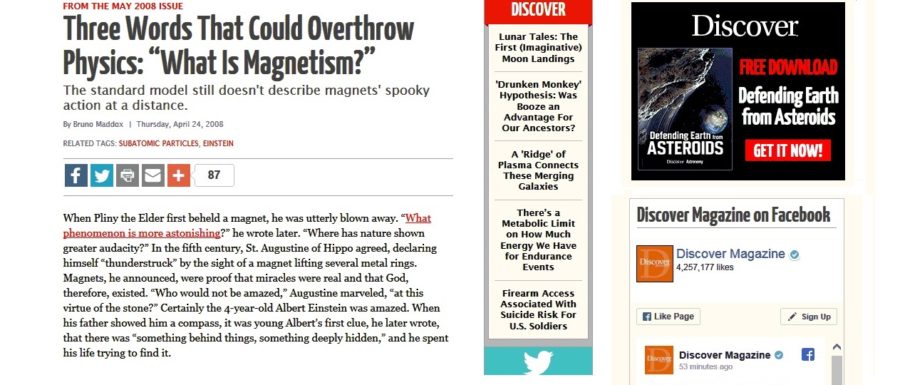 Image from Discover magazine
Image from Discover magazine
Yes, it is astonishing. Here we are in the 21st Century, and the Standard Model can’t explain how a magnet works. Because it can’t even explain the electron. That’s where it starts. It starts with the understanding that the electron doesn’t have an electric field or a magnetic field, it has an electromagnetic field. In fact it is electromagnetic field. We made it in gamma-gamma pair production, reconfiguring a 511keV electromagnetic wave called a photon into a spin ½ standing wave called an electron or a positron. Hence the wave nature of matter. When you wrap a sinusoidal electromagnetic field variation into a twisted double loop, the minimum and maximum field variations combine, along with all points in between, to leave you with an all-round phase-invariant standing field. As Feynman said, there’s a circulation of energy in this so-called static condition, there’s angular momentum in the field. The electron electromagnetic field looks static, but actually it’s dynamical, as suggested by the Poynting vector and evidenced by the Einstein-de Haas effect. The angular momentum is real. That’s why we have the right-hand-rule and the screw nature of electromagnetism. That’s why Hestenes used the word rotor. That’s why Radu and Volkov used the word vorton. That’s why Ehrenfest used the word spinor:
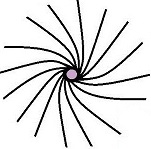
It’s a three dimensional thing, but it’s easier to grasp the 2D version. The point to appreciate is that the electromagnetic field is somewhat similar to the gravitomagnetic field. It’s a “twist” field. Note though that if you’re moving through it or it’s moving through you, you might think of it as a “turn” field. Or a rotor field if you prefer. That’s what a magnetic field is. That’s why in 1871 Maxwell said this: “According to Ampère and all his followers, however, electric currents are regarded as a species of translation, and magnetic force as depending on rotation”. The Faraday effect is where a magnetic field rotates the polarization of light. We can even make a magnet by turning or rotating a piece of iron, as per the Barnett effect. We don’t call it rot for nothing. That’s why the electron behaves like a tiny bar magnet because it is in itself a rotor of sorts. It’s an optical vortex that looks like a standing wave with a standing field. Schrödinger knew this. That’s why he talked about a wave group which gets into a small closed path. Then we call it an electron, and then when we move it, we call it electric current.
The current in the wire
The current in the wire is the simplest situation in which we see a magnetic field. It’s quite easy to understand why. The wire is made of copper. We have electrons that move and we have copper ions that don’t. Whilst a copper ion is far more complicated than an electron, it has the opposite charge, so let’s simplify it to the opposite spinor. Then we can draw two lines of spinors like this:
 Unattributed images are drawn by me. Note the optical illusion here, the arrow appears to slant downwards
Unattributed images are drawn by me. Note the optical illusion here, the arrow appears to slant downwards
The electrons are on the top row whilst the copper ions are underneath. There’s two sets of opposite twist fields, so they cancel. Hence you don’t see any net twist field. So there is no net charge, and no linear electric force, so we say there’s no electric field present. However the electrons are moving whilst the copper ions are not. And if you’re moving through a twist field or it’s moving through you, you might think of it as a turn field. You have relative motion with respect to the electrons only, so what you see is a net turn field. A magnetic field. We use the right hand rule to depict the concentric magnetic field lines, then we use Fleming’s right hand rule to remember how the electron moves:

The magnetic field lines point away from us where the electron is located. The electron is initially moving left to right, and there’s a rotational force orthogonal to both the magnetic field line and the electron motion. So the electron moves anticlockwise in a near-circular fashion around the magnetic field line. The electron goes around and around anticlockwise like a boomerang. A positron goes around and around clockwise like a left-handed boomerang.
The solenoid
Note though that the field around the wire isn’t uniform, because it diminishes with distance. Hence the electron path isn’t quite circular. That’s important, but we’ll come back to that after looking at why the electron goes around and around. For that we need a uniform magnetic field. When you bend the straight wire into a loop you alter the magnetic field, revealing its dipole nature. Then when you bend the wire further into multiple loops, what you’ve got is a solenoid. Then the magnetic field is the same as that of a bar magnet:
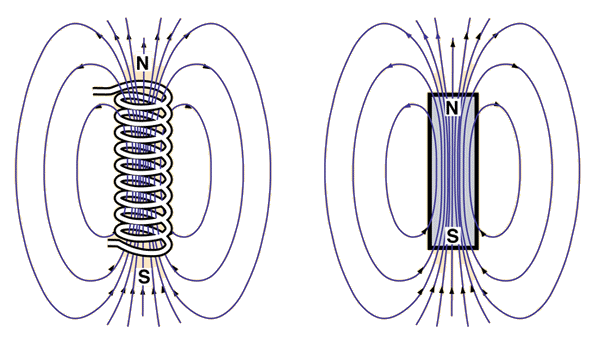 Image from Rod Nave’s hyperphysics
Image from Rod Nave’s hyperphysics
The magnetic field inside the solenoid is uniform, and the field lines are parallel. When you throw an electron through a clockwise solenoid, its motion is helical and anticlockwise.
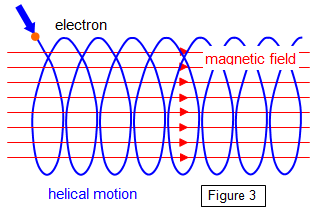 Image © Keith Gibbs 2013 see schoolphysics
Image © Keith Gibbs 2013 see schoolphysics
When you throw a positron through the solenoid, its motion is helical and clockwise. Either way there’s a longitudinal motion down through the solenoid, but the rotational component is still present. The electron still goes around and around anticlockwise like a ordinary right-handed boomerang. The positron still goes around and around clockwise like a left-handed boomerang. Now why might that be?
Why the electrons goes around and around
When you look into why a boomerang flies in a circular path, you soon find that it’s because of gyroscopic precession. Then it’s the work of but moments to find articles such as chapter 15 of Nicholas Turro’s Modern Molecular Photochemistry. In section 6 he says this: “Since the mechanics of the precessional motion of a gyroscope in the presence of gravity are of the same mathematical form as the mechanics of a magnetic moment associated with a spinning charged body in the presence of a magnetic field, we postulate that the vector due to the magnetic moment of the quantum magnet undergoes precessional motion in an applied magnetic field”. A gravitational analogy is also used in the Wikipedia gyromagnetic ratio article: “The earth’s gravitational attraction applies a force or torque to the gyroscope in the vertical direction, and the angular momentum vector along the axis of the gyroscope rotates slowly about a vertical line through the pivot”. Follow the link to Larmor precession and you can read that the spin angular momentum of an electron “precesses counter-clockwise about the direction of the magnetic field”. After that you soon find the Larmor radius. That’s also known as the gyroradius. It’s the radius of the circular motion of a charged particle in a uniform magnetic field. It seems fairly clear that the electron moves rotationally in a magnetic field because of gyromagnetic precession. Particularly since the positron goes the other way. See the MRI article by Allen D Elster: “two particles with positive and negative gyromagnetic ratios precess in opposite directions”.
Around and around and around and around
As for why precession results in rotational motion, remember that the electron is a “spinor” with a Poynting vector. When the electron is at rest think of it as light going around a circular path. When the electron is moving right to left, think of it as light going around a helical path. If you were to precess the front face of the helix, the whole electron would move helically, like it does when thrown through a solenoid. To visualize this, use a Slinky spring. Stretch it out straight to emulate an electron moving in a straight line. Then form it into a helix to emulate the helical motion of the electron through the solenoid. You may need the Lucky Penny Slinky Spiral to do this. It’s a Slinky with a spring-steel ribbon through the middle, plus end-caps. To form your Slinky into a helix, you just turn the ends. Then you have a helical helix. Not quite a double helix. If anything it’s more like a helix squared. It goes around and around, and around and around:
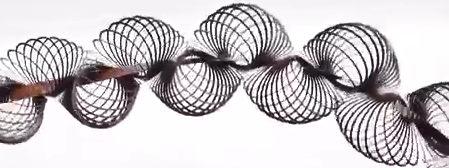 Lucky Penny Slinky Spiral, see Youtube
Lucky Penny Slinky Spiral, see Youtube
Throwing the electron along the current-in-the-wire is like throwing it through the side of a solenoid, or emitting it from the electron gun in a Teltron tube. Then it has no motion along the field lines, only around the field lines. The precession inclination angle is 90 degrees, and the motion is circular rather than helical. It’s like forming your Slinky into a circle rather than a helix:
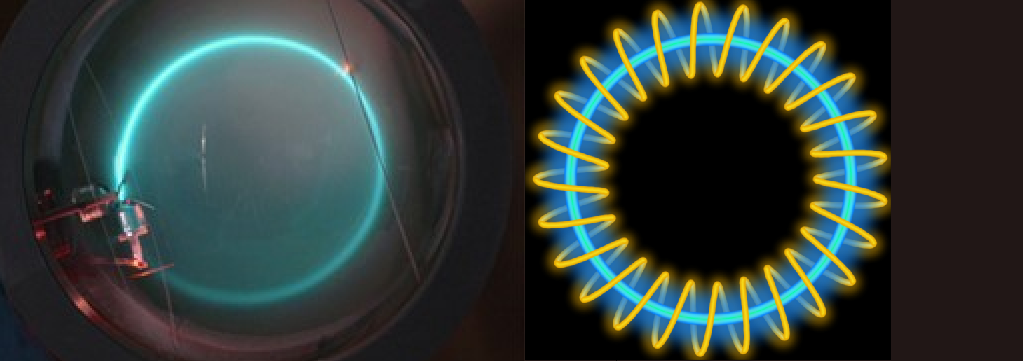 Teltron tube image from demoweb UCSC Slinky+neon image by Ofnuts
Teltron tube image from demoweb UCSC Slinky+neon image by Ofnuts
Note though that the magnetic field within a solenoid or a Teltron tube is uniform, so the electron path is circular or helical. However the magnetic field around the current-in-the-wire is not uniform. It diminishes with distance in the wire. So the electron path is near circular. This is important. This is why a magnet is a magnet. An iron cylinder will be attracted into a solenoid, but once it’s inside the solenoid the magnetic field is uniform, so there’s no more force on it. There’s no net force on a magnet in a uniform magnetic field, because the force is equal and opposite on opposite poles.
The force on a charged particle
When the particle is going around and around in a uniform magnetic field, there’s no net force on it. There’s a turning force, a torque, but this is symmetrical, and the motion of the particle is uniform. See Magnetic Torque and Magnetic Force from Michael Salvati at NYU physics for more: “in a uniform magnetic field there is no net force on the particle, but there is a torque and the angular momentum will, in some sense, precess about the magnetic field”. The particle goes around and around, but it doesn’t speed up, and it doesn’t really go anywhere. However when the particle is in a non-uniform magnetic field there is a net force on the particle. There’s a non-rotational force on the silver atoms in the Stern-Gerlach experiment because the torque is not balanced. That’s’ why the “spin up” silver atoms go up, and the “spin down” silver atoms go down. See Chris Skilbeck’s Cronondon for another description of the Stern-Gerlach experiment. Also see Particle Spin and the Stern-Gerlach Experiment by James Cresser: “the non-uniformity of the field means that the atoms experience a sideways force”. There’s a net force on the silver atoms, and it isn’t there because of length contraction. That’s a myth invented by Edward Purcell in section 5.9 of his 1963 book Electricity and Magnetism. It’s still promoted to this day, with bizarre claims that the wire acquires a net negative charge. It doesn’t. The force is there because the magnetic field is not uniform, and because the silver atoms have an unpaired 5s electron. Because an electron is a spinor, and it’s either spin up or spin down with respect to the rest of the silver atom.
The force on the electron
It’s similar for electrons moving parallel to the wire, either in the same direction as the current, or not. The magnetic field surrounding the current-in-the-wire is not uniform. The field gets weaker as you move away from the wire, so the electron motion isn’t quite circular. The Larmor radius nearer the wire is less than it is further away from the wire, and the result is a sideways Grad-B drift. Throw an electron along the wire from right to left in the opposite direction to the current, and it spins up towards the wire anticlockwise, then down again. Throw a positron and it spins down away from the wire clockwise, then up again, so it drifts the other way:

This is important because an atom is a combination of opposite-charged particles, wherein the Lorentz forces nearly cancel. And when they nearly cancel, there’s a net force on the atom.
The force on an atom
Let’s simplify the atom down to one positron and one electron. Then when we throw the atom to the left the stronger force is downwards, and when we throw it to the right the stronger force is upwards. But if we swap the positions of the electron and the positron, when we throw the atom to the left the stronger force is upwards, and when we throw it to the right the stronger force is downwards:
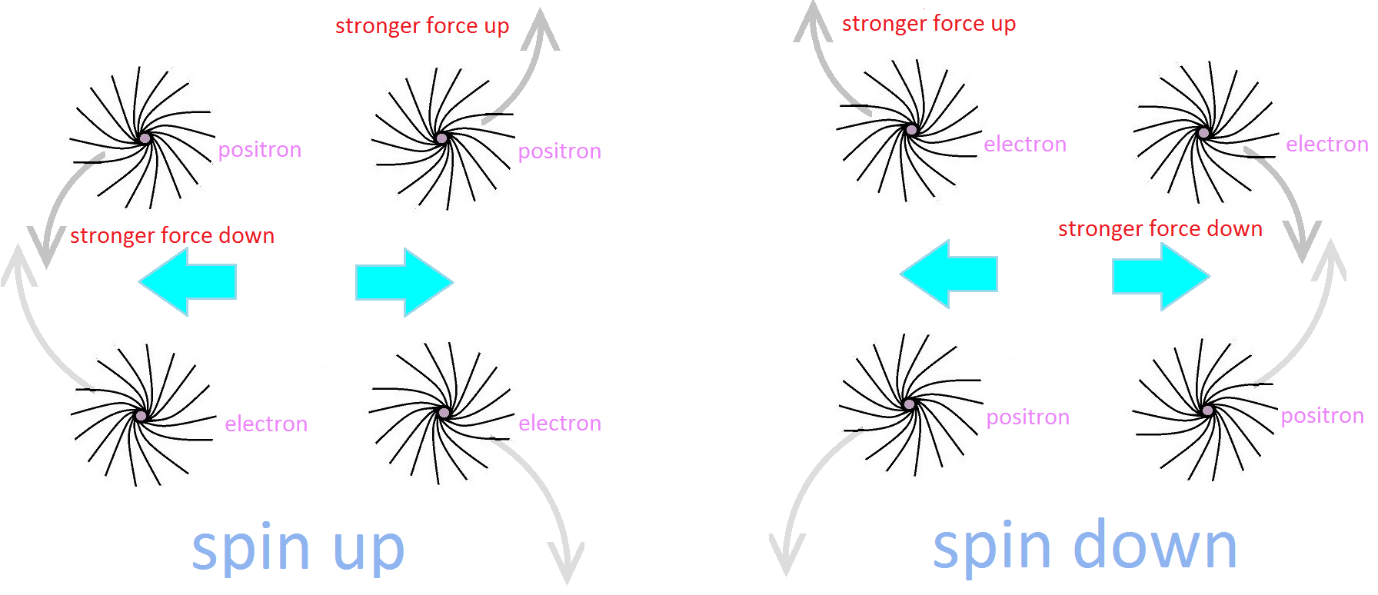
Hence the atom moves up or down depending on its direction and motion and the disposition of its spinors, which we can label as spin up or spin down. Either way the rotational forces don’t balance, so there’s a net force, one way or the other. See dipoles and magnets by Lawrence Rees. The atom moves, either up or down. If you throw it along the wire to the left into the current, it moves down away from the wire. If you throw it to the right with the current, it moves up towards the wire. And since for every action there’s a reaction, there’s a force on the wire too.
The force on the wire
So, if you throw your atom to the right with the current, the atom moves towards the wire, and the wire moves towards the atom. If you scaled this up to a string of copper atoms plus a stream of electrons, you effectively have a second wire. Hence two wires with currents flowing in the same direction are attracted to one another, as per Ampère’s Law.
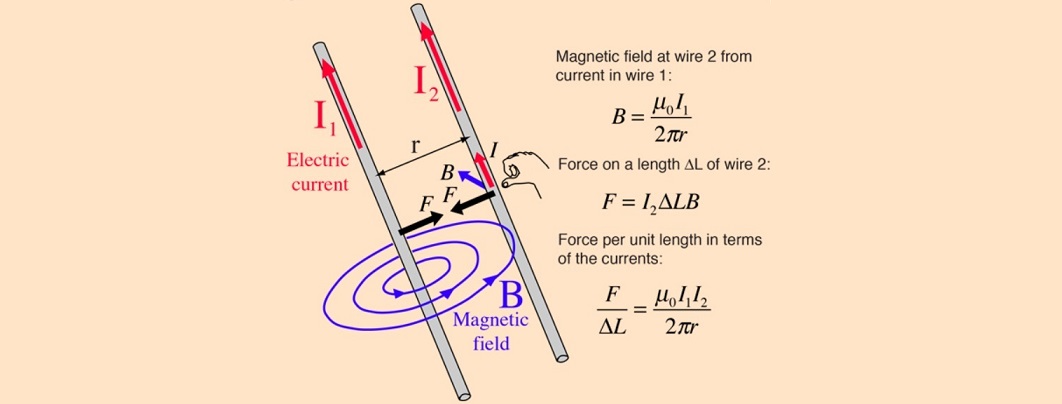 Image from Rod Nave’s hyperphysics
Image from Rod Nave’s hyperphysics
Likewise two wires with currents flowing in the opposite direction repel one another. The force is very weak, because it’s a “trace” force that’s only there because the raw electromagnetic forces don’t quite balance. It’s a pale shadow of the very powerful Coulomb force between charged particles. When you stop the electrons moving there’s an even weaker trace force called gravity, but that’s so weak you wouldn’t notice any force between the wires. You need those currents flowing to notice a force. Like I said, you need two wires with currents flowing in the same direction for attraction, and two wires with currents flowing in the opposite direction for repulsion.
The force on a magnet
It’s the same if you bend your wires into current loops. If both currents are clockwise or anticlockwise, the loops attract. Otherwise they repel. When you scale this up to a series of loops to form a solenoid, then if both have a clockwise current they attract one another. When you turn one solenoid over it now has an anticlockwise current, and the solenoids repel. Either way, it’s because on the way into the solenoid the field is not uniform, and the forces don’t balance. It’s the same for a bar magnet, only we call one end the North pole and the other end the South pole. When you scale it up to the size of the Earth, we still call one end the North pole and the other end the South pole. We have the Aurora Borealis and the Aurora Australis because those forces don’t balance. The bottom line is this: a magnet works because it consists of spinors which exert linear and rotational forces on other spinors. Whilst the linear forces balance, the rotational forces don’t, because they diminish with distance, and the result is weaker attractive and repulsive forces between the North and South poles of a pair of magnets.
Secrets of the ancients
I think that what’s really interesting about all this is that it goes back two hundred years. See Michael Littman’s Princeton article on Oersted’s Theory. It says “Oersted proposed that a vortex-like, circular distortion existed around the wire”. It says Oersted said “motion in circles, joined with a progressive motion, according to the length of the conductor, ought to form a conchoidal or spiral line”. You can read Oersted’s short paper on a French website called Ampère and the history of electricity. There’s an article called Ampère lays the foundations of electrodynamics by Christine Blondel and Bertrand Wolff. It says “rare were those physicists who accepted Oersted’s vortex explanation, but Ampère was one of them”. In 1820 Ampère invented the word solenoid, and noticed that a solenoid had a magnetic field like a bar magnet. He said “if the spirals acted like magnets, it was because magnets owe their magnetism to electric currents in planes perpendicular to their axes”. Search on vortex and you can find Ampère’s researches in the science of electrodynamics. That’s where Ampère said this: “Is it not evident, then, to all how memorable would that discovery be that would rigorously establish the fact that to magnetize a needle is to excite, to put in motion around each molecule of the steel, a small, circular, electrical vortex?” Ampère said they were a version of Descartes’ planetary vortices, on a smaller scale. He also said this: “There are on the surface and in the interior of a magnet as many electric currents in planes perpendicular to the axis of this magnet that one can imagine a series of lines forming closed curves without cutting across each other”. Here’s the picture, it’s figure 15 on page 32 of Exposé des nouvelles découvertes sur l’électricité et le magnétisme:
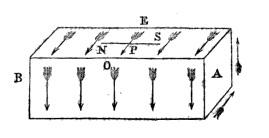 Image by Ampère and Babinet
Image by Ampère and Babinet
This suggests macroscopic electric currents, but he referred to “un infinité de courants electrique situés tout autour dans le plans perpendiculaires à l’axe”. An infinity of electric currents situated all around in the planes perpendicular to the axis. And note this from Ampère and the history of electricity: “starting on 15 January 1821, moved by a suggestion by Fresnel, he presented another hypothesis, that of currents around elemental particles [“courants particulaires”]. Each particle of the magnet would be surrounded by a circular current around an axis parallel to that of the magnet”. In a later paper in 1826 Ampère referred again to particulate currents, and to an electrodynamic helix. Impressive stuff, and as the Princeton article says, “Ampère’s model is startlingly close to the truth. There are no circular molecular currents after all, but the spinning electrons act just like loops of current”. What a pity Feynman didn’t pay attention to this, or to Maxwell’s theory of molecular vortices, or pursue the circulation of energy associated with the Poynting vector. If he had, he would have been able to explain how a magnet works. He wouldn’t have had to say “I can’t explain attraction in terms of anything that’s familiar to you”. In his best Brooklyn accent, he could have explained a magnet in about two minutes forty.
How a magnet works
Interviewer: What I want to know, is what’s going on between these two bits of metal?
Feynman: They repel each other. As to why, well now, the thing you have to know about, is the wave nature of matter. And that the electron is a “spinor”. It’s a wave going around and around [Feynman rolls his finger]. We know this because of something called the Einstein-de Haas effect. Think of the electron as something like a cyclone. Particles attract each other and go around each other like counter-rotating vortices. [Rolls two index fingers around one another]. Or they repel each other like co-rotating vortices. [Rolls fingers backwards]. In an ordinary material all the forces cancel each other out, but in the current-in-the wire, which is the simplest magnet, they don’t. That’s because the electrons are moving [stabs index finger] whilst the copper ions are not. Because of this, another nearby electron moving in the same direction as the current is subject to a net rotational force [rolls finger]. It goes around and around just like a boomerang, due to precession. But the rotational forces aren’t balanced because the field diminishes with distance, so there’s a net force towards the wire, and since for every action there’s a reaction, there’s also a force on the wire towards the electron. The opposite is true if the electron is moving in the opposite direction to the current. Then when you have a whole lot of electrons in a copper wire the same rules apply. So two wires with currents going the same way attract, and two wires with currents going the opposite way repel. Then when you bend your wires into multiple loops, each is a solenoid. When your electrons are going the same way round both solenoids, the solenoids attract. But flip one solenoid over and the electrons are now going the opposite way, so now the solenoids repel. A bar magnet is the same. André-Marie Ampère worked that out in 1820. Smart guy. A bar magnet has the same sort of magnetic field as a solenoid because electrons are spinors going around and around, all the same way. [Rolls his finger]. Look at this picture from a book he wrote. [Holds up book]. See how they’re all going around the same way? When you break a magnet in half, each half still has a North pole and a South pole, because the North pole is just looking at all this rotation from above, and the South pole is just looking at it from below. That’s why there are no magnetic monopoles. You want to know about them too?
Interviewer: Yes please.
In Electricity and Magnetism by Edward Purcell, magnetism is explained as the result of the Special Theory of Relativity on electrons moving (or “spinning”) at near the speed of light. The book is a free PDF on the internet, and was used as a Berkeley Physics course textbook.
It’s in section 5.9 Doug. I thought I’d talked about this, but I haven’t, not on this website. All I said was there’s a net force on the silver atoms, and it isn’t there because of length contraction. I have elsewhere, on say Quora. Purcell’s “explanation” is totally wrong. Magnetism is nothing to do with length contraction. How on Earth that stuck I do not know.
Hey John, I just had Feynman’s infamous interview on how a magnet works come serendipitously come accross my Google News feed. WHAT A HOOT ! Poor guy was totally lost on the subject and resorted to all sorts of sketchy bullshit rhetorical nonsense, his body posturing was even more hilarious. About the only two things I did learn was : 1. Feynman was a real jerk in this interview, 2. I now know where Theoria Apophasis learnt his science from.
Feynman used to be my hero. Despite the bad way he treated women. Hey, nobody’s perfect, OK? I looked up to him because I liked his little books, and because he was known as “the great explainer”. But then I learned some physics, and some physics history, and did some explaining of my own. Now I think the guy was a fraud who went along with all the cargo-cult science stole and stole other people’s work.
I just found it hilarious he was squirming all the way thru the interview like me trying to explain the fine structure constant to anyone,anywhere.
I speculate if he was one of the first to conclude it was easier and more profitable to be a celebrity first ? I also wonder if that also happens when people chase after the Nobel ? No need to respond John, I am simply thinking out loud and I do mean simply.
Yes, he couldn’t explain it, and he was ducking and diving. Did you like explanation I think he should have given, at the end of the article? Anyway, I think the guy who first concluded that it was easier and more profitable to be a celebrity, was Einstein. He didn’t really achieve much after he became famous in 1919. He wasn’t perfect either. There was the issue in the early days when he didn’t credit the relativity pioneers, there was the Gerber controversy, and there was the GR priority issue. However I don’t demand perfection. Nobody’s perfect, including me. But IMHO Feynman was a lot less perfect than I used to think. Now I don’t think he was the great explainer any more, I think he was the great bullshitter.
Yes , I thoroughly enjoy your fantasy story on what should have been said . It is my go-to source on the subject of how a magnet works. You did a great job of explaining things in layman’s terms with 100% scientific accuracy. I still would not know how a magnet truly works without your writings John !
It makes sense that Einstein was probably the first media celebrity physicist. I do know that he treated his first wife Mileva Marcic very poorly, and was not such a great father either. She probaly deserves a lot more credit for his accomplishments than most people know about.
Many of us,including myself have put heroes up on pedestals while ignoring their personal flaws and imperfections. Down thru the years I have been able to compartmentalize other’s accomplishments from their human foibles. But as in Feynman,Gell-Mann and many others their professional misconduct can’t be held separate. Charlatans don’t deserve no respect.(at least Feynman never stole my typos and lousy American grammar)
Disregard my earlier question about how a magnet works. I found it! Lots of great stuff on this site. Also, I grew up with Will Kinney, and wonder what his thoughts would be regarding your criticisms of the physics community. I will ask if I have the chance
Thanks Randall. I hope this explanation is correct!
As for Will Kinney, there’s plenty here to interest him. Such as the article on inflation.
Wow!
Love this website. Mucho eluciation!!
Why thank you Ed.
.
If you have any particular interest perhaps I could point you at the right article? I’ve been writing about one article a month since 2018. There now 94 articles!
” Frustrated Magnets ” ??? Anything new or serious here Boss ?
https://phys.org/news/2024-12-physicists-uncover-strong-interactions-quantum.html
I read it Greg. My conclusion is that it’s total hype, bollocks, and lies to children. See this bit?
.
“This analogy connects the study of quantum spin liquids with quantum electrodynamics (QED), the theory that describes how electrons interact through the exchange of photons and forms the foundation of the Standard Model of particle physics.
.
Electrons do not interact through the exchange of photons. Hydrogen atoms don’t twinkle, and magnets don’t shine. Those photons are virtual photons, as in not real. As for the magnetic monopoles, don’t these people understand that the electron has an electromagnetic field, not a magnetic field or an electric field? It’s like they never read what Maxwell said. And as for the “implications for quantum technologies like quantum computing”, it’s never going to happen because quantum entanglement is scientific fraud. How typical of Nature to publish speculative garbage like this when they point-blank refuse to publish electron papers.
Ditto with all the hoopla about the Willow Chip. I’d rather have a bucket full of ” cow chips “, at least you use them for garden fertilizer………
Yes, have you seen this garbage? Google says its new quantum chip indicates that multiple universes exist. I have only one word for that: charlatans.
Inspirational article. Makes me wonder about possibility of software simulator of matter with resolution to a photon, electron, etc. that gives full characteristics of matter in desired volume (e.g. forces, effects). Who knows maybe all states of matter are already known and world just weights for such programs to play with parameters and materials?
Thank Tony. The article I wrote last month was about simulations. I think it would be great to simulate a photon, then gamma-gamma pair production, then the electron and the positron, followed by electron-positron annihilation. After that would come a simulation of the proton, then the hydrogen atom, then the neutron and the neutrino. Then would come the more complex nuclei along with electron shells. What a great thing that would be!